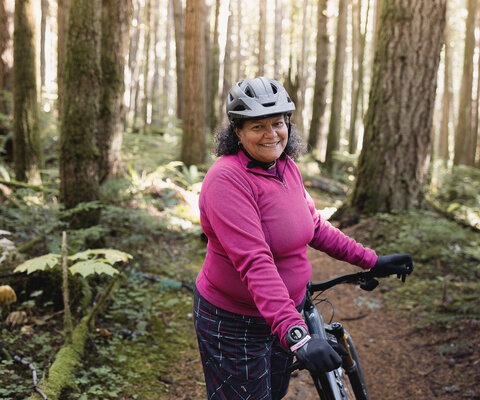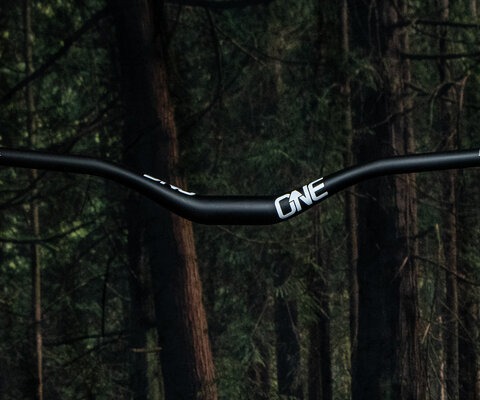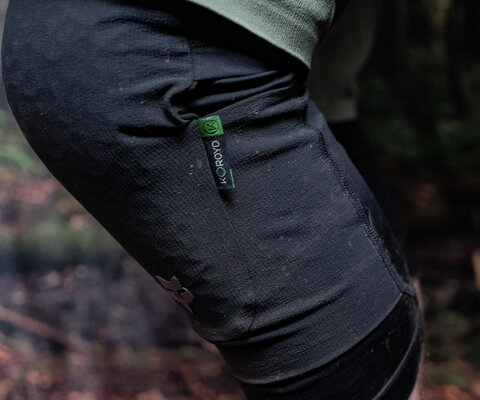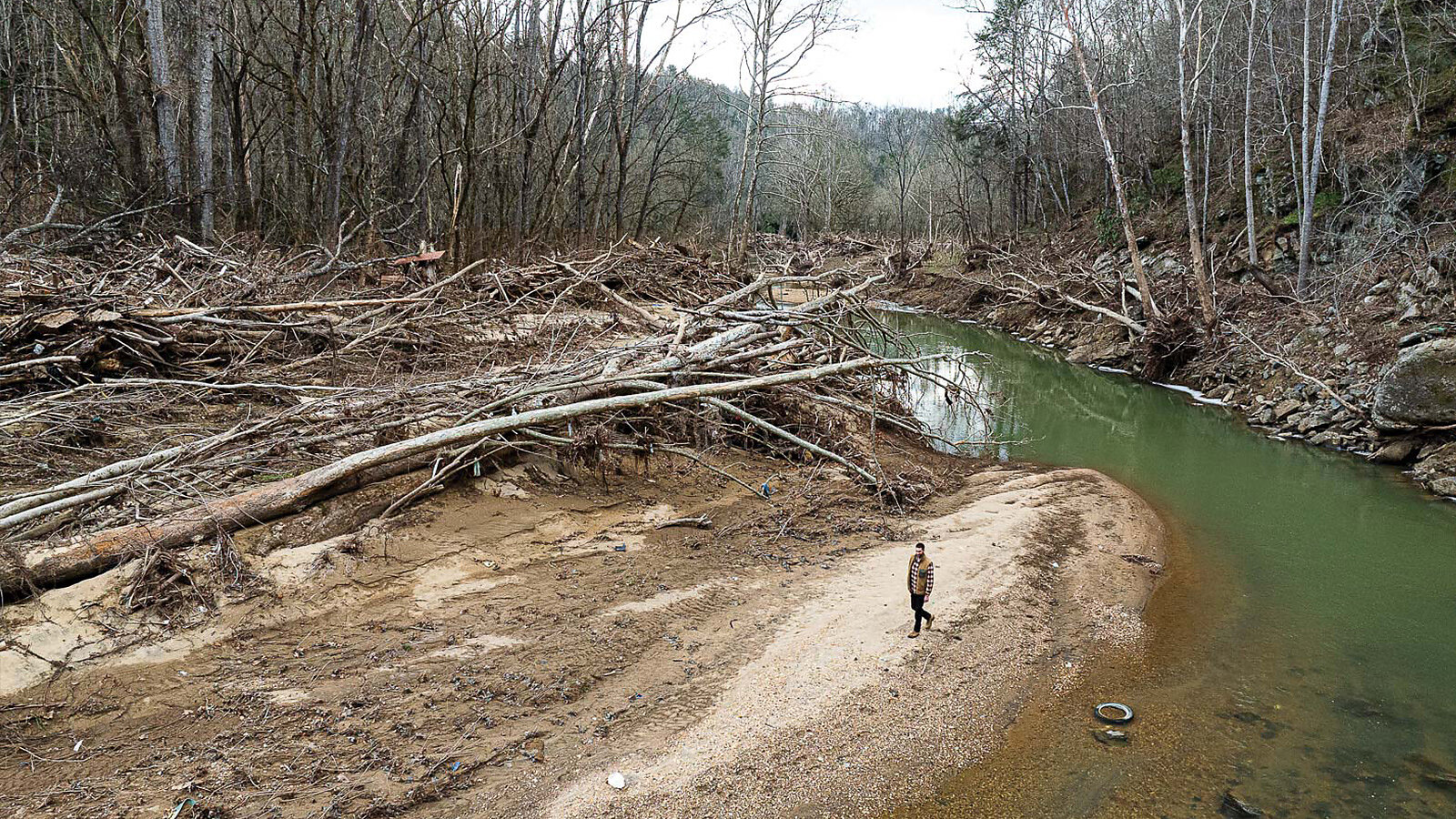
Higher Ground Resilience in the Aftermath of Hurricane Helene
Words by Kristian Jackson | Photos by Derek DiLuzio
Peter Mills stands with the toes of his work boots at the edge of the Ivy River north of Asheville, North Carolina. The warm January day, while strange, is a pleasant change from a long, cold, and snowy winter in the mountains of western North Carolina.
Mills, president and owner of Elevated Trail Design, started his company on the cusp of the modern era of trailbuilding in this region. His approach to trail projects is tempered by a business management degree from the University of North Carolina Asheville Center for Health and Wellness and his years growing up on local trails. Mills’ resume now includes high-profile projects such as YouTube star Seth Alvo's Berm Park in nearby Canton, the Greenslick trail in Pisgah National Forest, and countless other projects in the area.
Under Mills’ feet, the portion of the Ivy River that delineates his property radiates a peculiar cobalt glow. The water flows gently among coarse river rocks, their grain showing an oxidized newness creating a nostalgia for idyllic western rivers carved by glaciers.
Turning around, he scans acre after acre of debris piled up on his riverbank—whole trees lifted into piles 20 feet high and intertwined with door jams, joists, and roof beams. Broken medicine cabinets intermingle with fragments of family photo albums.
A few months prior, on Friday, September 27, 2024, Hurricane Helene smashed into western North Carolina. The storm dropped more than 30 inches of rain and flooded rivers to levels not seen since the Great Flood of 1916. It triggered over 2,000 landslides and damaged more than 600 roads, 800 bridges, and 70,000 homes. In its wake, Helene left 100 people dead.
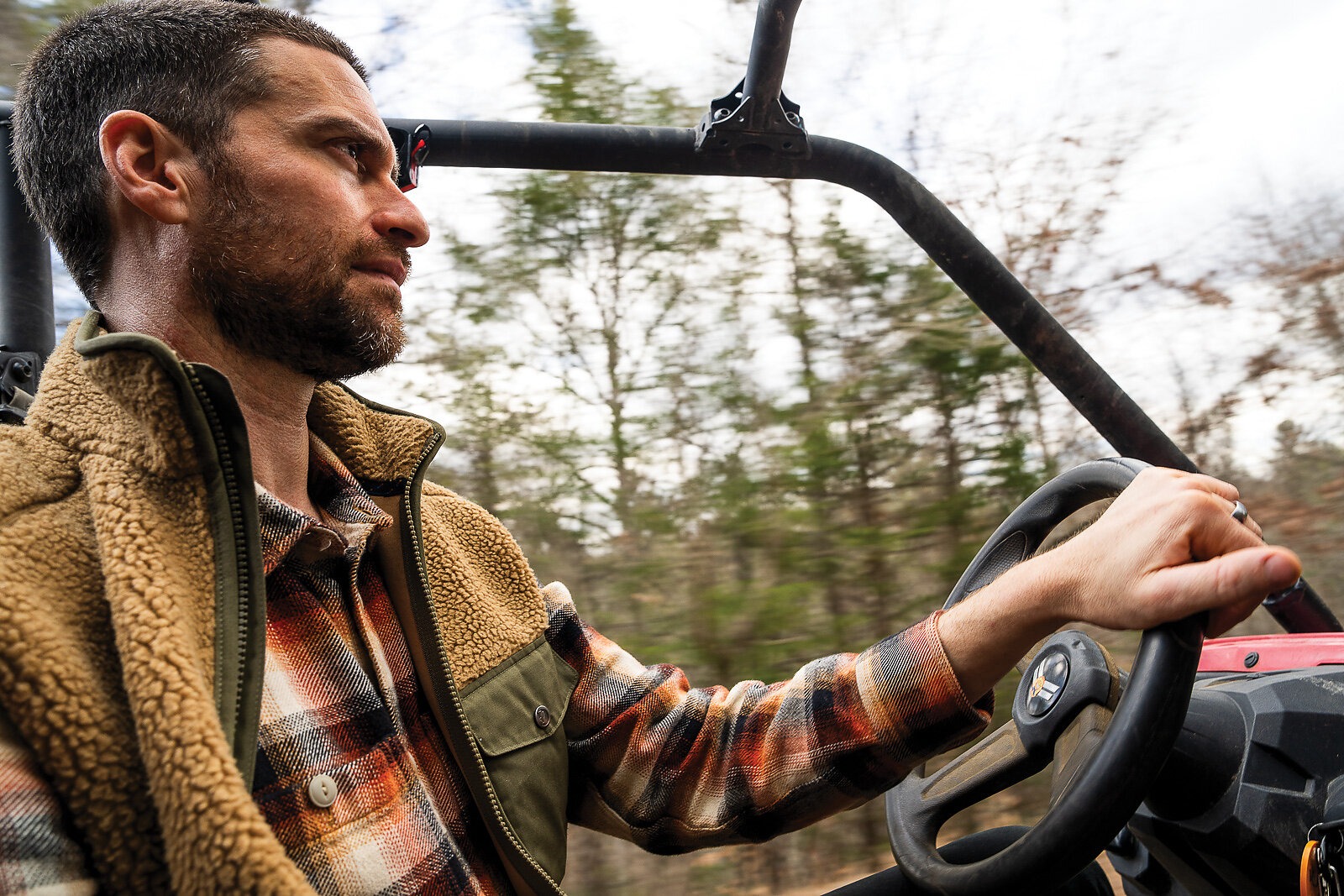
Everyone in the Blue Ridge Mountains of North Carolina was impacted. For the trail community who call the 500,000 acres of Pisgah National Forest home, that Friday marked a day when, perhaps for the first time, trails were the last thing on anyone’s mind.
Mills stirs uneasily as he recalls going down to the river with his wife Sarah the day after the wall of rain passed through this part of the mountains.
“Our little stream is usually 20 feet across, and here it was 250 feet across, easily 25 feet above the riverbank,” Mills says, “We watched propane tanks and gigantic trees bob up and down. The stink of propane was kind of overwhelming … It’s seeing kids’ stuff that makes me wanna lose it. I don’t know if I’ll ever get this cleaned up.”
Mills is no stranger to hard work. He built his company from a one-man operation to a small team of dedicated builders equipped with an arsenal of trail machines. His company is now equipped to plan, design, build, and maintain any type of trail. He specializes in bike-specific trails that maximize fun and jibby riding, an homage to his dirt jumping and slopestyle background. Never, he says, would he have predicted his skill as a builder would be used to help with recovery in such a stark disaster.
The Mills’ spent the immediate days after Helene in a daze. Cut off from the outside world, they received bits and pieces of information that jolted them into sporadic action. Sarah heard from a neighbor that a child upstream had washed down the river and that the father dove in himself in desperation. The Mills’ went to the river to look, calling out, but to no avail. Peter went to the river several times those first few days and watched as the waters receded, leaving colossal piles of debris.
On Monday morning, Sarah noticed a police officer—visibly distraught—lumbering out of the woods into their yard. The officer confirmed that his team was searching for missing people and that they needed vehicle access to the river. The Mills’ jumped into action, Peter driving officers to the river in his UTV and Sarah driving one of the trail excavators that Peter had in his shop.
“Not only does our community need to get back into the woods for mental and physical health. But also for just being able to have this escape from the disaster that we all just experienced.” —Natalie Narburgh
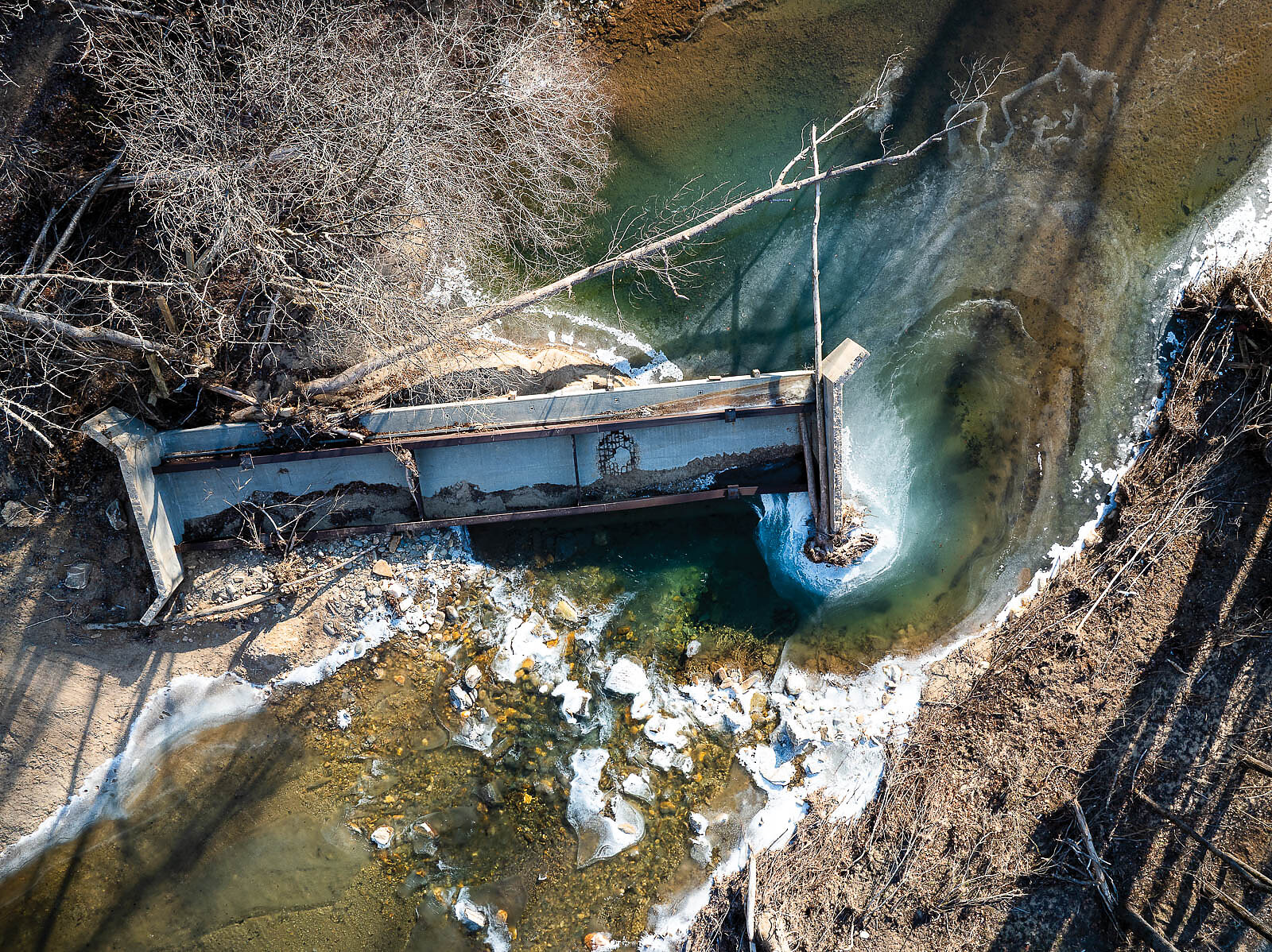
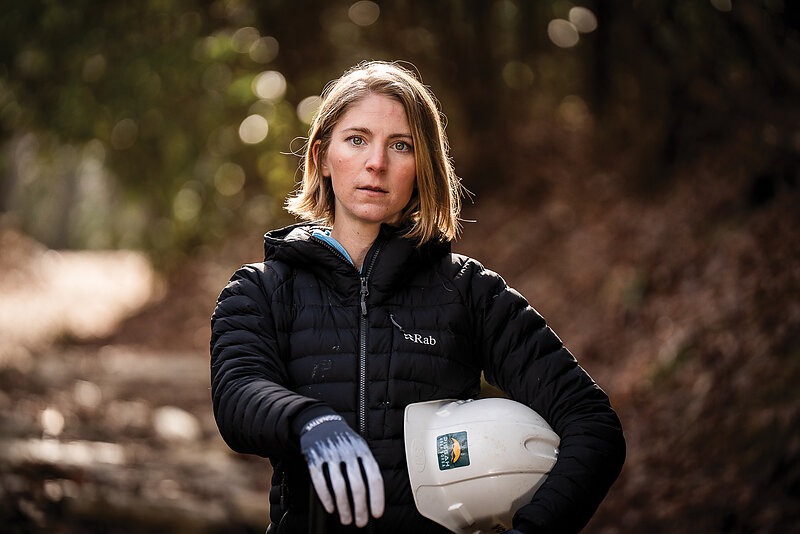
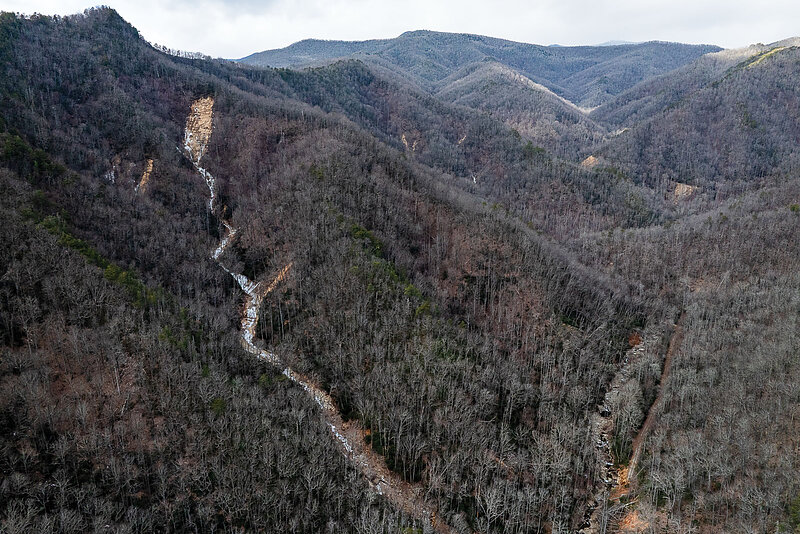
As they used the excavator to claw through walls of debris, they saw the reality before them. Boats were deploying cadaver dog teams who marked piles where they had “hits.” A helicopter buzzed overhead. The enormity of the situation began to sink in. Once Mills had established a path to the riverbank, he began to pull apart the marked piles in search of lost souls.
“It was one of the most overwhelming feelings,” Mills said, looking helplessly into the piles, all of which are still there. Several weeks after the storm, Mills and his crew returned to Greenslick, a trail they had helped build earlier in 2024, to assess damage and work to reopen and repair it.
“People need trails, especially now,” he said, “And once Pisgah Area SORBA got the green light to get back into the forest, we were all about getting Greenslick opened back up.”
Greenslick is a bike-optimized trail in the Bent Creek area of Pisgah National Forest, just on the southwestern edge of Asheville. The local trail advocacy organization for mountain bikers, Pisgah Area SORBA, received a grant to rebuild it earlier in 2024 and selected Mills’ company for the job. The trail was newly opened when the storm hit and closed all of the National Forest.
Natalie Narburgh, the executive director of Pisgah Area SORBA lives near Bent Creek and, in September 2024, was looking to carry the momentum the club was finally making with trails in its part of Pisgah, the Pisgah Ranger District. Narburgh, an energetic outdoorswoman and mom, steers mountain bike trail stewardship from Asheville to Brevard. Through her operational acumen, relationship building, and leadership, the club has grown into a critical partner for the Forest Service, taking on major projects such as the Black Mountain, Butter Gap, and Greenslick overhauls and working to avoid future trail closures or reroutes through proactive stewardship. The club’s critical work helps the Forest Service overcome its own lack of funding for trail maintenance.
“When the storm hit, I started to connect our volunteers,” Narburgh said. “We used our Slack channel and started connecting them with some of the grassroots groups that were going out to assist people who needed help.”
The volunteers traded their usual tasks of cleaning out drains and brushing to mucking out crawl spaces, sawing trees off houses, and carrying gallons of water to neighbors. The club’s level of professional organization enabled it to respond quickly and robustly to immediate human needs.
When the Forest Service announced they would allow access to the trails between Asheville and Brevard, no one knew what they’d find. Pisgah Area SORBA rallied its crews to venture into the unknown, shifting from immediate rescue needs to a longer-term recovery effort.
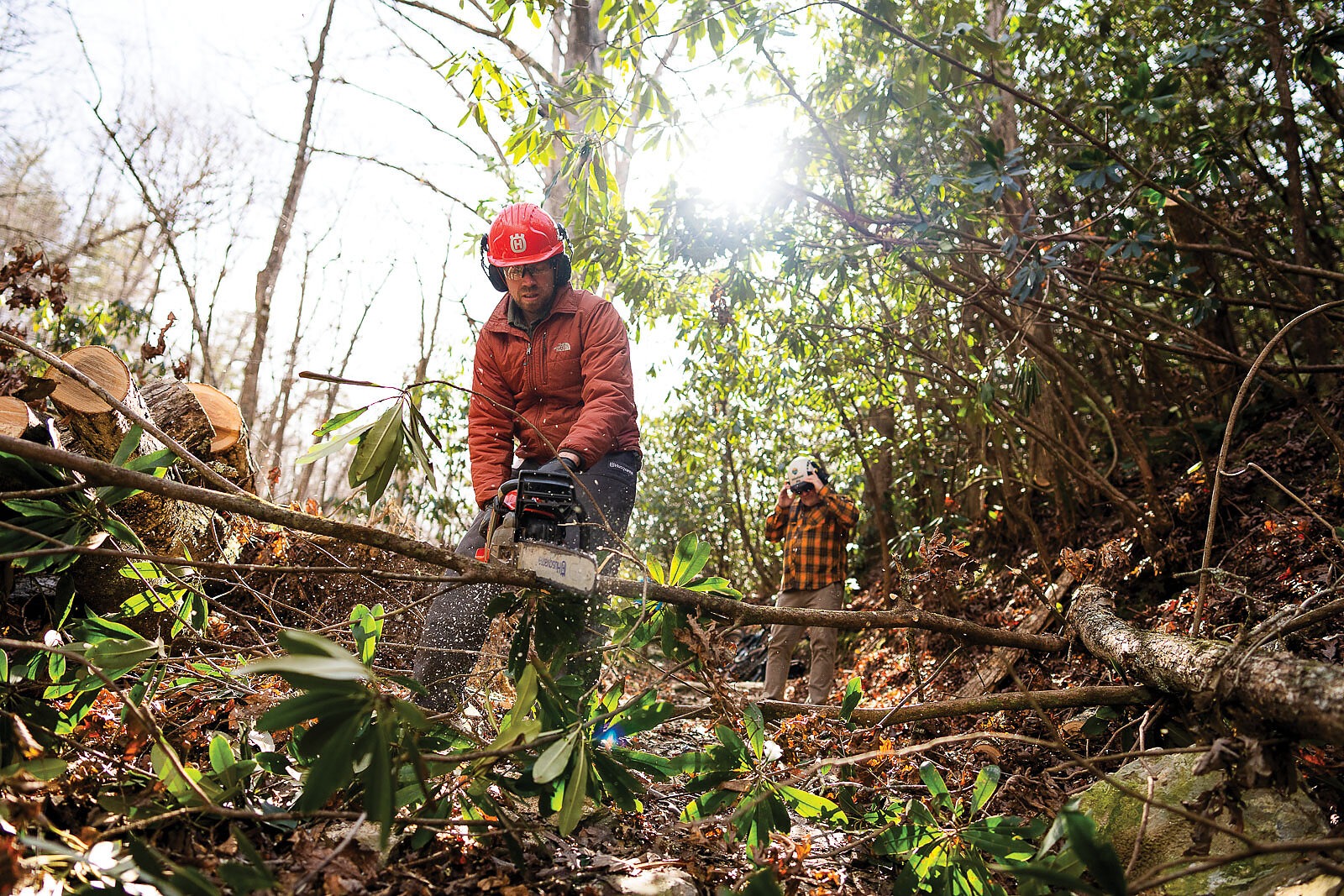

“Not only does our community need to get back into the woods for mental and physical health,” Narburgh said, “But also for just being able to have this escape from the disaster that we all just experienced.”
The club took a two-pronged approach to its efforts. One aspect was getting the volunteers onto trails to see what needed to be done. The second was communicating trail conditions to the public on a daily basis. The club’s talented and committed paid staff and deep bench of skilled volunteers went to work.
Within the first days Pisgah Area SORBA cleared more than 500 fallen trees from over 30 trails. In the first 13 days after the forest opened, the club hosted 11 organized workdays in addition to work being done by certified sawyers who were cutting trees every day. This success, Narburgh said, was largely due to the dedication to the organizational systems of the club. Trail crew leaders, professional record keeping, paid staff, effective social media, industry partnerships, and superlative communication all added up to one of the region’s most beloved trail systems coming back online in short order.
“My husband shares a story of one of his coworkers who lost their house and all of their belongings,” Narburgh said. “But they would show up joyful to work, and they would just talk about how lucky they were to have made it through with their family. That’s perspective. My family didn’t have potable water for 54 days, but I’m so lucky I have a house that wasn’t damaged. And now our trails are open. Our community is so lucky [especially] when the rest of Pisgah National Forest districts aren’t open.”
The other districts of Pisgah, the Appalachian and Grandfather districts east of Asheville, are home to steeper, more rugged, more remote terrain than the Pisgah District near Brevard. These slopes, dominated by the 6,684-foot Mount Mitchell, the highest peak east of the Mississippi River, and Grandfather Mountain, represent the most peak to valley elevation change on public lands in the East. These mountains rise like a wall out of the piedmont and faced every bit of Helene’s full fury.
“The water came up quick at camp,” said Jason McDougald, remembering that fateful Friday. “Maybe 3-4 feet in 30 minutes.”
McDougald serves as the executive director of Camp Grier in the Grandfather Ranger District, just east of Asheville in Old Fort, North Carolina. He’s an adventurer with trail running, mountain biking, and the elegant but elusive pursuit of southern ice climbing on his to-do list, and he serves as a steadfast community leader and visionary founding member of the G5 Trail Collective. McDougald’s propensity to sport Bedrock sandals to meetings often belies his political savvy. His down-to-earth approach to large-scale administration creates human-centric organizations that simply get shit done.

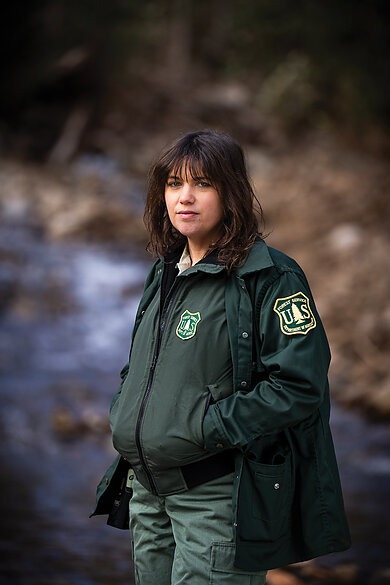
"There were just no riders in the county, no bike culture, and nobody was really taking care of those trails,” McDougald said, recalling the area’s scene around 2018 before the G5 Trail Collective was born. “We knew we wanted to build trails to create that culture, but the only way to do it was to show the Forest Service that we could care for what little we already had.”
McDougald helped hatch a plan to connect one of his area’s renowned trails, Heartbreak Ridge, to the town of Old Fort. This connection would span the entire eastern escarpment from near 5,000 feet and descend to town at an elevation of 1,300 feet, creating 11 miles of outstanding, rugged riding.
This vision helped spur the creation of the G5 Trail Collective, an organization housed out of Camp Grier that would partner with the Grandfather District to develop a trail system that would provide access to remote stretches of forest, create a trail culture within the community, and foster economic development in Old Fort. The plan worked. With the Grandfather District Rangers as a partner and 42 miles of new trail planned, McDougald put his shoulder to the fundraising and lobbying grindstone and raised more than $2.5 million to see the project to completion. The momentum was contagious. New trails opened with a frequency never seen in the area—including Lower Heartbreak Ridge, a modern backcountry masterpiece that embodied the vision from years before.
“The trail crew had just pulled out on the 20th mile that Thursday before the hurricane hit,” McDougald said. “We were about halfway through and, at first, it kind of felt like you had this nice shiny car and you drove it off a lot and somebody slammed into you. You know, it’s like you didn’t do anything wrong. You had your seat belt on, and you did all the right things but, you know, somebody still smashed into you anyway.”
After Helene passed, McDougald walked two miles from camp into downtown Old Fort. The train tracks that follow the road and Mill Creek resembled an HO model train set in disarray. In places, the tracks hung in midair.
“In town, there were people walking around stunned in their house coats and bare feet,” McDougald said. “They just watched their homes float away and didn’t have anywhere to go.”
Shocked by the apocalyptic scenes he’d witnessed, McDougald walked back to camp and did what he does best: Put a plan together to help the community.
“We felt good at camp,” he said, “We had food, had ice, a Starlink, so we thought, ‘Let’s get camp open.’” Within a few days they’d raised $60,000 to install a “big ass” generator. And, within a week, Camp Grier was up and running.
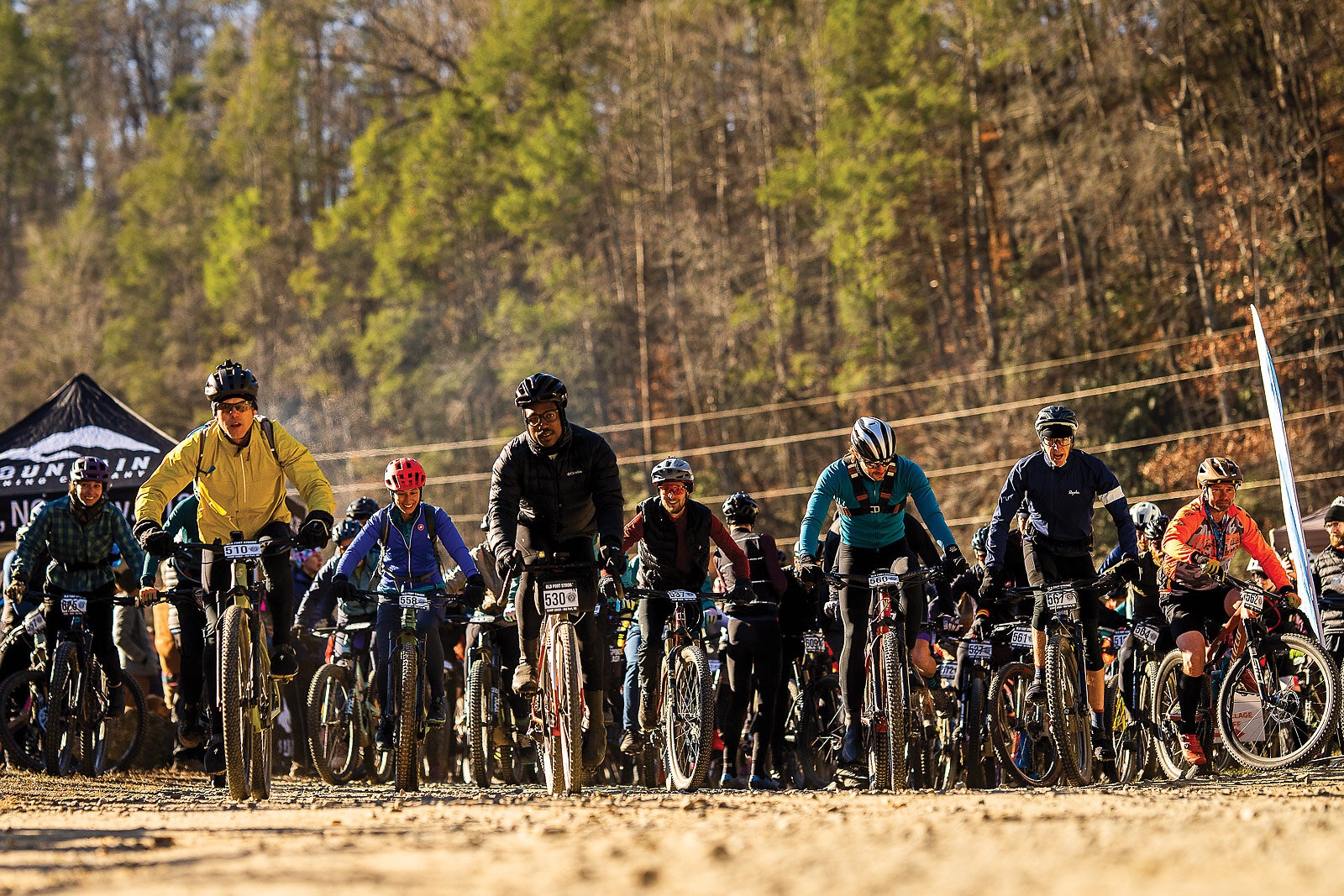
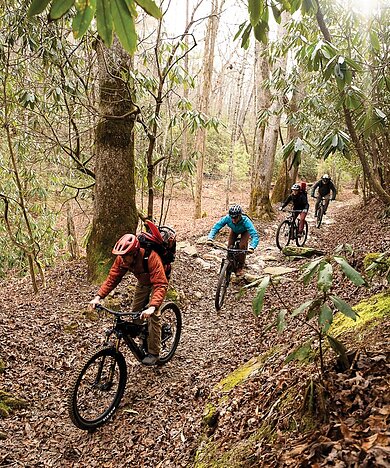
In just a few days, the camp had transformed from a place of summer fun into a community assistance zone resembling a refugee shelter in the middle of a war zone or major disaster. The camp began serving the Old Fort community 300 meals, providing 75 showers, and washing 50 loads of laundry each day. They worked nonstop from October 1 to December 1.
“We were working 80-hour weeks with no days off,” McDougald said. “People would ask what we needed and I would say, ‘Busch Light and coffee.’”
In town, entire houses had been lifted off foundations and laid to rest on roads, fields, and in some cases, on top of other homes. Seeking respite from relentless dust and grime in town, residents would walk to Camp Grier just to sit on the porch and drink a beer in peace with camp staff. As the days ticked by, members of the G5 team made forays into the woods to assess and record trail damage.
“It was hard to wrap my head around losing trails that I love,” McDougald said.
Landslides ripped from the ridgetops to the creek beds in this area. Scars 1,000 feet long and 800 feet wide are now commonplace. Log jams 30 feet high and acres upon acres wide, where steep creeks flatten at valley floors, make parts of the forest unrecognizable. And then there’s the human toll in Old Fort—47 homes gone, 36 damaged. All in a town of 800 people.
In December 2024, after the camp stopped its recovery operations, McDougald and his crew planned a “Backyard Ultra” race to raise money for the Old Fort community and the people who lost their homes. The turnout defied expectations— 450 racers showed up for the event, helping raise more than $1.2 million.
Lisa Jennings is a ranger in the Grandfather District and has worked closely with G5 and other partner groups to grow recreational opportunities in the National Forest. Her olive-drab uniform and yellow hardhat give away her government employee status. But when she speaks in her energetic mountain lilt, she reveals she is of the people, and for the people. Part environmental scientist, part land manager, and part wilderness philosopher, Jennings has clocked over a decade of public conservation work in the Grandfather District and is a newly certified crosscut sawyer.
“I really see my role as a connector,” Jennings said. “Our public lands are something I believe should reflect the needs and values of our communities that surround them.”
In the past decade, Jennings’ efforts have been evident in several ways: the impressive number of new trails developed, such as the Old Fort Complex; the high-quality partnerships formed; and, most importantly, the positive change in how the public perceives both the forest and the Forest Service. Her work has forged a sea change with local mountain bikers, who prior to her work in the district, felt despondent on public lands. Every new trail that has come online under her tenure has had input from mountain bikers.
Helene unleashed catastrophic damage on Jennings’ home community of Black Mountain, just between Old Fort and Asheville. Roads and bridges washed away, businesses flooded, and electric lines ripped apart and lay submerged in a stew of water, raw sewage, and gasoline.
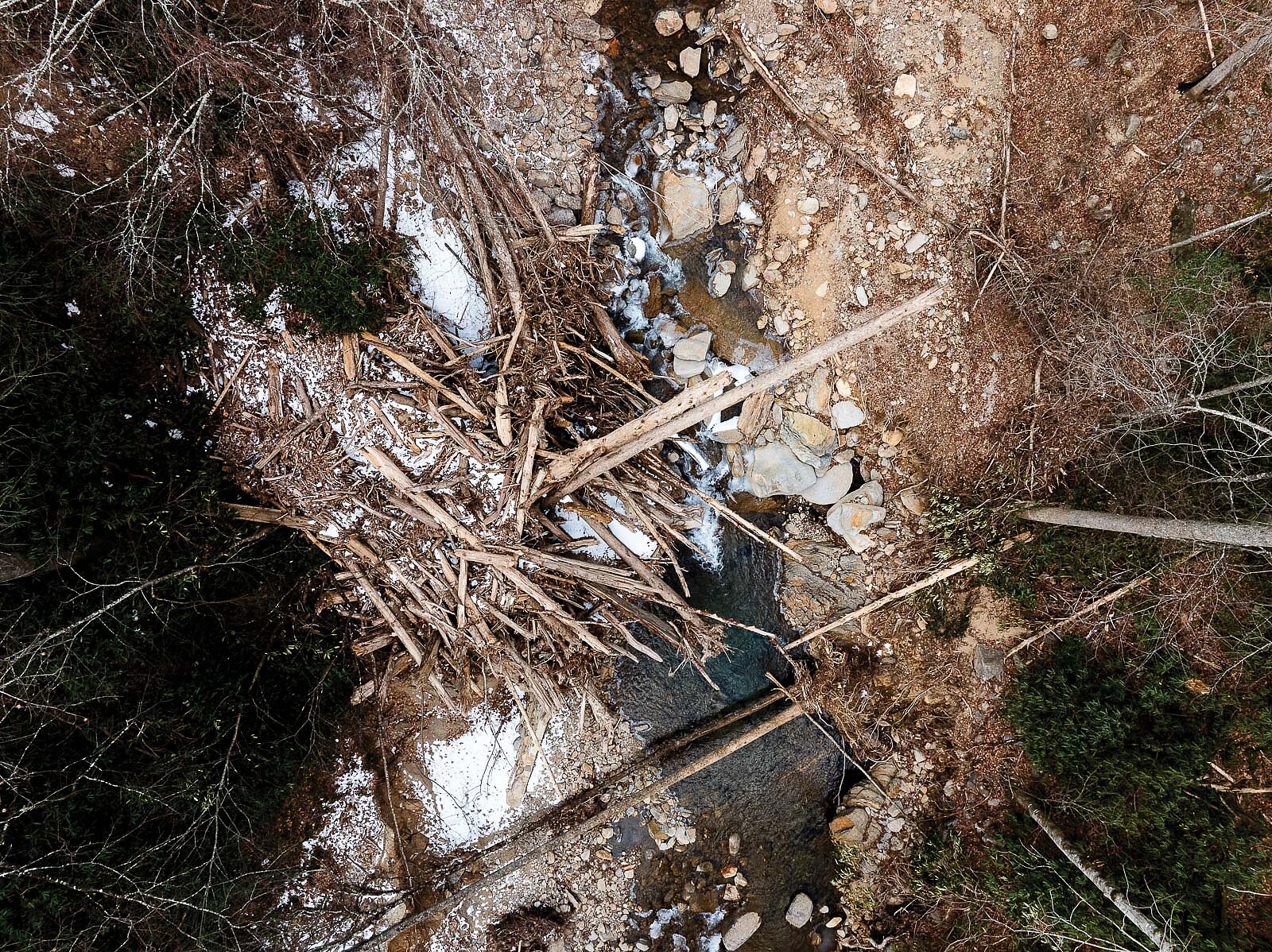
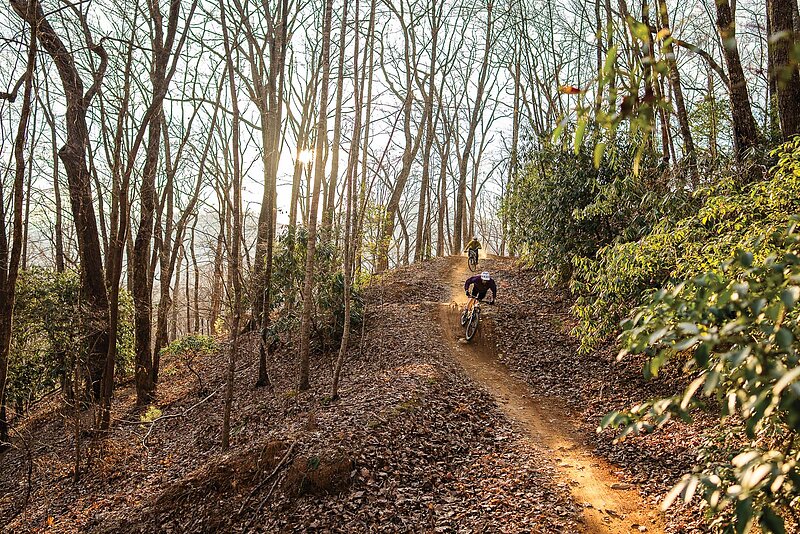
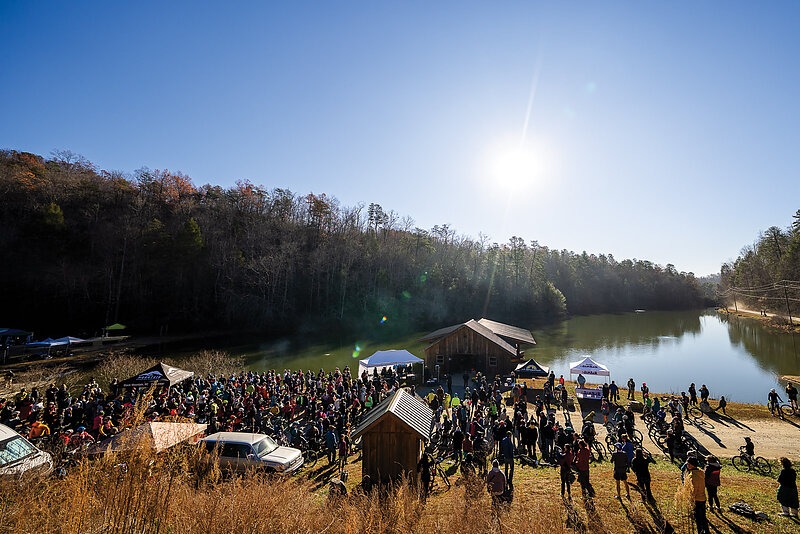
“All the neighbors came out and we started grilling before the food went bad,” Jennings said. “It was like a block party. We had no information about what was going on outside of Black Mountain.”
After hearing about a town meeting, Jennings went to the police department to offer help. She walked into a chaotic, ad hoc command center and quickly realized that her experience fighting wildfires, managing incidents, and serving as a public safety officer was needed immediately. She hopped on her bike and rode, Paul Revere style, telling anyone who would listen to get to the public square meeting. That first meeting attracted 1,000 people and was the first broadcast public meeting via Blue Ridge Public Radio.
“My direction to the team in those meetings was to tell the honest truth—as much as we knew, even though we didn’t have many answers early on—so that folks could make the right decisions for the safety of their families in the early days,” Jennings said.
Standing on one side of Curtis Creek on a crisp day in early 2025, a major drainage of the Catawba River watershed, Jennings looked across where a bridge used to be. On the other side is the parking lot to the centerpiece of the Old Fort Trail Complex: the now inaccessible Gateway Trails. Here, the storm ripped a mammoth concrete bridge out of its foundation and turned it wrong side up downstream.
“The Old Fort Trail Complex definitely got hit worse than almost any other area in the forest,” Jennings said. “It’s really the epicenter of the destruction.”
That destruction led to deep conversations between McDougald and Jennings.
“Jason told me a while back, ‘Never let a good crisis go to waste,’” Jennings said. “You get those moments of grief, but then you accept it and think, how can we learn from this? And how can we build back something that’s gonna serve the community and the landscape even better?”
Parts of the flagship Lower Heartbreak Ridge are gone. An 800-foot stretch of the Newberry Creek trail is scoured to bedrock. And it’s questionable if some parts of the forest will ever recover. But inside of the human, economic, and environmental toll of the storm, there is a collective realization that trails might be the higher ground that connects everyone. Recently, Jennings attended a public event where questions about trails were posed.
“The trails were the symbol of hope,” Jennings said. “Just knowing that the trails could open comforted folks. We think about these trails as places of solace and healing, but it just made it so real. Even if they couldn’t get there, knowing that some trails were OK and that they were still there was really important. It brought people to tears of joy.”
For generations, the mountains of western North Carolina have been a place of refuge and solace. The Cherokee hid from the advancing U.S. Army deep in its coves. Runaway slaves found protection and paths to freedom. Early industrialists sought an escape from city life in the clean air and expansive vistas of the Blue Ridge Mountains. Today, some local multi-generational families are stunned by the fact that their mountains not only couldn’t protect them, but that they unleashed irreparable damage.
“We can’t change what happened. But we can actively restore and create resiliency within the system,” Jennings said. “We can show that we are making actions that help the mountains go back to the way they were.
